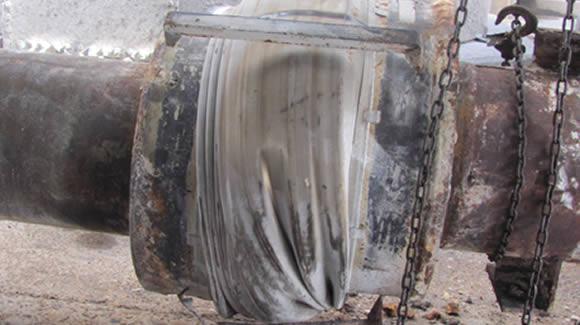Expansion joint failure modes
Expansion joint failure can occur for various reasons, but experience shows that failures falls into several distinct categories.

Failed Competitor Expansion Joint
This list includes, but is not limited to:
- Shipping and handling damage. Examples: Denting or gouging of bellows from being struck by hard objects (tools, chain falls, forklifts, adjacent structures, etc.); improper stacking for shipping or storage; insufficient protection from weather or other adverse environmental conditions.
- Improper installation and insufficient protection.
- During and after installation .
- Examples: Joints with internal liners installed in the reverse direction with respect to flow; installing an expansion joint in a location other than as prescribed by the installation drawings; premature removal of shipping devices; springing of bellows to make up for piping misalignment; insufficient protection from mechanical damage due to work in the surrounding area; insufficient protection of bellows during nearby welding operations and failure to remove shipping devices before placing system in operation.
- Improper anchoring, guiding and supporting of the system.
- Anchor failure in service.
- Bellows corrosion, both internal and external.
- System over-pressure (in-service or hydrotest). Bellows vibration (mechanical or flow induced resulting in high cycle fatigue).
- Excessive bellows deflection (axial, lateral, angular deflections greater than design values).
- Torsion.
- Bellows erosion.
- Packing of particulate matter in the bellows convolutions which inhibits proper movement of the bellows.

